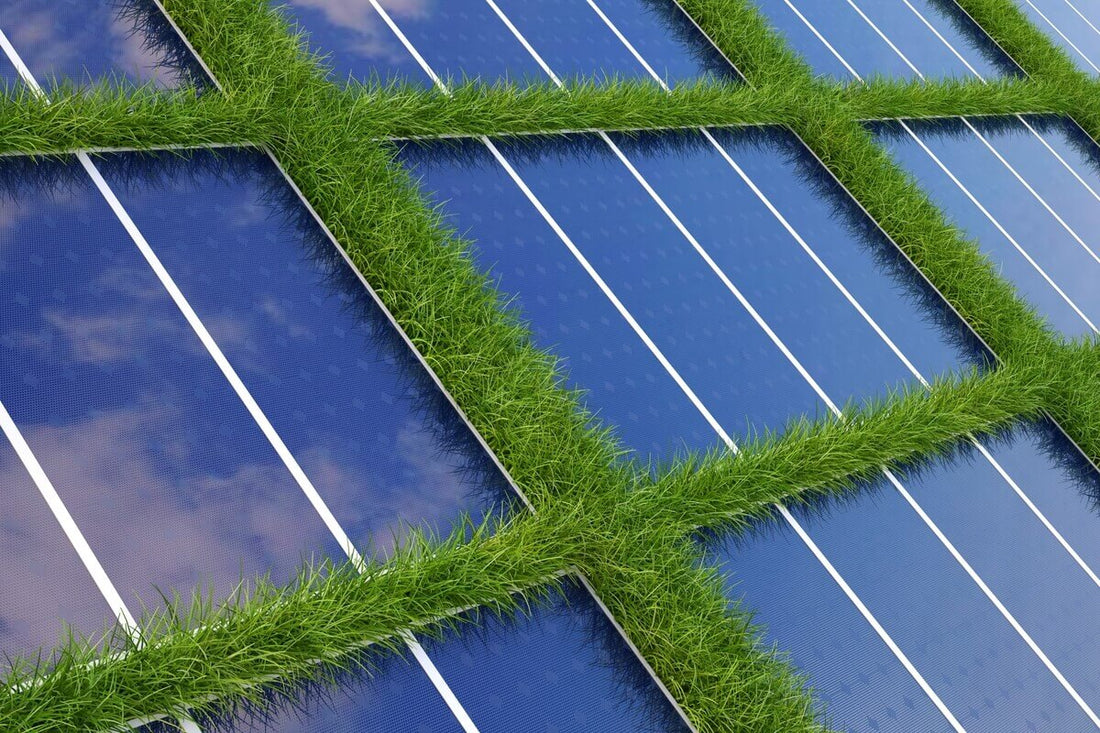Estimated reading time: 10 minutes
The fact that solar energy is good for the environment is not mind-blowing, groundbreaking, or new. But here, we’re going to cover exactly why solar is as environmentally desirable as people claim.

Sometimes it feels like the things that are good for you and good for the environment are bound to be pricey.
You can see this everywhere. For example, a meal of sustainably harvested wild Pacific salmon (high in Omega-3, Vitamin B, protein, and other nutrients) and organic, ethically sourced fruits and vegetables is going to cost more than a couple packets of Ramen, a can of Spam, a bag of potato chips, and a bottle of Mountain Dew.

When it comes down to it, it can be hard to choose options that are organic, ethically sourced, eco-friendly, green, etc., while alternatives are cheaper.
When quality and earth-friendliness are associated with high prices, being environmentally conscious is going to be seen as an exclusive luxury.
However, when it comes to energy production, solar panels are verifiably the cheapest form of energy while offering significant and direct environmental benefits. Solar panels are like the $3 salmon dinners of energy.

In the 21st century, energy production methods and energy consumption levels have changed and will continue to change. Renewable energy sources like solar are becoming increasingly accessible and sought after for several reasons:
- Generally, people are more aware of ways that traditional, nonrenewable energy sources can harm the environment.
- Solar systems are more affordable than ever (due to the maturation of the solar industry and panel technology, state and federal incentives, net metering, etc.).
- The health and environmental benefits of implementing solar panels are significant on both the local and global levels.
The environmental health of our planet weighs on the minds of many—even outside of the purely scientific realm of climatologists and geologists.
In modern popular culture, the seemingly endless stream of films and works of literature that depict a futuristic, dystopian Earth is a testament of the environmental issues' prominence. Pollution and climate change are not simply fictional extremes—they're serious reality.

Public discourse surrounding climate change has shifted from debating “Is it real?” to “What can we do?”
Solar panels have taken their place as the golden child of renewable energy, and the great news is they’re only getting better from here (financially and environmentally).
The purpose of this article is to address the following questions:
1. How do solar panels benefit the environment?
2. Do solar panels harm the environment in any way?
3. Environmentally, are solar panels worth it?

The implementation of the federal solar tax credit, the ITC, the solar industry has boomed. Until recently, solar panels were not affordable to most and consequently, they were much rarer.
The Project Solar Difference
While solar has comfortably established itself as the cheapest energy source (renewable or nonrenewable), there are still significant price discrepancies within the industry.
Here at Project Solar, we believe that clean energy is for everyone. As a company, we price solar at half the national average. We are able to do this because we focus on e-commerce principles and do not employ any incentivized salespeople whose salaries ultimately bloat the price of solar.
This is a huge win for renewable energy. The more accessible solar is, the more consumers will install systems and do their part in creating a cleaner, more sustainable world.

1. How do solar panels benefit the environment?
You don’t have to have a deep understanding of environmental issues and energy production to see and understand solar energy’s green benefits. The green benefits of solar energy are pretty straightforward and very significant.
Solar vs. Fossil Fuels
When a home pulls energy from the local utility company or “the grid,” the electricity that they are consuming was produced by the burning of fossil fuels. Power plants burn fossil fuels, such as coal and natural gas, to create heat which generates steam which then drives the turbines that generate electricity.

The burning of fossil fuels is not seen as “clean” or “green” energy because fossil fuels are nonrenewable resources. Although fossil fuel resources replenish over time, the rate at which they replenish is incredibly slow . . . and they are consumed at a much faster rate.
Fossil fuels also have harmful emissions. These emissions not only cause damage at a more local level by affecting air quality and respiratory health, but they are also known as greenhouse gases because they create a greenhouse effect in our atmosphere and are connected to global climate change.
As greenhouse gas emissions have dramatically increased over the past century, global temperatures have experienced dramatic changes which historically have taken place over much longer periods of time.

The problem is, however, that communities and countries are dependent on fossil fuels.
Anyone who has lost electricity temporarily in their home realizes how even the simplest tasks and routines require electricity to function. We are constantly flipping light switches, heating and cooling, driving, cooking, and more.
Innovations that require fossil fuels have simplified our day-to-day lives, so it is not realistic to propose a complete and immediate renouncement of fossil fuels; however, it is not only very important but completely reachable for modern society to search for and develop alternative energy sources.

Solar is the Ultimate Renewable Resource
With all these current concerns in mind, solar energy is amazing.
The power of the sun is reliable, strong, and the ultimate example of a renewable energy source because collecting energy from the sun doesn’t decrease the sun’s power in any way.
No matter how many people have solar panels, the potential amount of energy to be collected is not affected.
By replacing fossil fuels with solar, the negative effects of fossil fuel emissions are consequently diminished.
Since climate change and air pollution are intimidating issues, consumers may feel powerless in their ability to make a difference. However, the effect of transitioning one home to solar power from fossil fuels is equivalent to planting around 150 trees every year.

Solar Energy Helps Improve Air Quality
The energy choices of single people make significant differences. Along with shrinking your carbon footprint, switching to solar also improves air quality.
While the burning of fossil fuels increases greenhouse gas emissions such as carbon dioxide (CO2), producing electricity through solar power helps reduce harmful emissions.
Cutting down on emissions helps improve respiratory and cardio health on a global and local level. The National Renewable Energy Laboratory (NREL) has found that lower fossil fuel emissions result in fewer cases of bronchitis and lost workdays related to health issues.

By investing in solar power, you are investing in the planet and your personal environment. Solar energy is a significant step forward to creating a more sustainable life.
While there may be environmental issues that you can’t directly control, solar is worth it because it’s a way you can make a difference today.
2. Do solar panels harm the environment in any way?
Clearly, there are strong environmental advantages to choosing solar as your energy source, but it is important to recognize that there are still some weaknesses.
Humankind has not yet discovered an energy source that could technically be labeled as 100% "green." There are some environmental concerns surrounding solar panels' manufacturing and recycling/disposal processes.
Environmental Pitfalls of the Solar Recycling Process
Currently, solar panel disposal has not been a prominent topic of discussion since panels have robust 25-year production warranties and often continue to produce electricity for years beyond the warranty.
The vast majority of solar owners are still on their original set of panels since over 95% of PV modules deployed in the U.S have been installed since 2012.
Currently, in the US, the treatment of end-of-life panels isn't regulated and organized since it is up to the discretion of the states. However, the US has some good examples to follow when it comes to photovoltaic (PV) panel recycling.
The EU, Japan, and other jurisdictions around the world hold PV installers accountable for their waste.
Existing Solar Recycling Programs in the US
While there are inconsistent practices across the country, there are states like Washington that have a PV module stewardship and takeback program, meaning that every panel supplier must submit a recycling plan by July 2022.

While Washington state has a plan, three of the top five solar states in the US (Arizona, Florida, and Texas) are only applying common waste regulation when it comes to panel disposal.
In the United States, there are a couple of PV recycling programs that have already been set into motion, such as Recycle PV, PV Cycle, and the SEIA National PV Recycling Program. There are also several manufacturers that help facilitate recycling such as SunPower and First Solar.
Recycling Complications With Materials
So, why is solar panel recycling not more straightforward?
Panels are composed of silicon solar cells, metal framing, glass sheets, wires, and plexiglass. Silicon solar cells are the most essential component to producing electricity and (unfortunately) the most difficult to recycle.
While more than 80% of a typical panel’s weight comes from glass and aluminum, which are both common recycling materials, hazardous materials can be in the panel’s wafer cells, thin-film cells, solder, cover glass, and backsheet.
The National Renewable Energy Laboratory encourages manufacturers to avoid these materials because they complicate the recycling process. Many panel manufacturers, such as Hanwha Q-Cells ( one of Project Solar’s panel providers), do not pose any risk of hazardous chemicals.

Solar panels are difficult and expensive to recycle since their different components have to be separated.
In Europe, the requirement to recycle has created a market for panel recyclers, and a more unified push for the recycling process in the US will naturally create jobs and solutions that will help deal with recycling issues as more panels reach the end of their lifespans.
The Environmental Pitfalls of the Solar Manufacturing Process
Currently, solar panels’ manufacturing process produces greenhouse gas emissions.

These gases are emitted as silicon is prepared for the panel. Silicon is a solar cell’s primary material and the most essential electrical component. It is derived from quartz, which has to be mined and heated in a furnace. This process causes sulfur dioxide and carbon dioxide (CO2) to be emitted into the atmosphere.
In addition to sulfur dioxide and carbon dioxide emissions, there are also toxic materials within the thin-film panels, such as cadmium telluride and copper indium selenide. It is important to note, however, that thin-film panels are typically used in large commercial or utility solar projects, not residential.
These chemicals are commonly used while manufacturing cell phones, laptops, and other electronics. While they can be considered hazardous during the manufacturing stage, they aren’t so once the product is assembled and used.
This reality can be disappointing since many who are interested in solar energy want to lower greenhouse gas emissions. However, despite its few environmental weaknesses, solar still accomplishes this.
As solar panel manufacturing becomes more efficient, its carbon footprint shrinks significantly. To demonstrate this, a 2016 study reports that the overall emissions produced in this process have decreased by 17–24% every time install capacity has doubled in the last 40 years.
Additionally, the overall greenhouse gas emissions involved in solar energy are still much lower than coal or natural gas. Just because there are emissions does not mean that solar is a dangerous or bad option—it’s still a significant improvement when compared to fossil fuels.

A 2011 report proved this fact. It was found that solar’s carbon footprint averaged at roughly 85 tonnes of carbon dioxide equivalent (CO2e) per gigawatt-hour (GWh), while natural gas averaged 499 CO2e/GWh and coal averaged 888 CO2e/GWh.
How should these environmental weaknesses be approached?
In closing, it is important to be aware of solar’s environmental weaknesses so that the industry can continue to improve.

However, it is also important to keep these weaknesses in perspective and not to disregard the many ways that solar is still a more environmentally conscious energy source than other nonrenewable resources and a cheaper option for homeowners.
3. Environmentally, are solar panels worth it?
Solar panels’ abundance and magnitude of green benefits make going solar an environmental no-brainer. Modern lifestyles require us to look forward to renewable energy solutions which will allow solar to be implemented in space-efficient and environmentally friendly ways. Although panels unavoidably take up space, installers can problem solve and find the most ideal locations for panels to minimally disrupt the natural environment. Roofs of homes, sheds, patio shades, parking pavilions, and other pre-existing structures can optimize for energy production and fulfill other needed functions.
Ground-mounted utility panels also take the flora and fauna of an environment into consideration to create as little disturbance as possible. Solar farms are encouraged to plant native grasses and wildflowers in low-maintenance areas to help create habitats for bees and other species to reduce long-term maintenance and emissions in the area.
Solar also outstrides other renewable energy sources when it comes to eco-friendliness and price.
For example, nuclear and hydropower require significant amounts of water. Water can be considered a renewable resource if usage, temperature, treatment, and release are carefully controlled, but often overuse can occur and cause harm to local environments.

Groundwater bodies are considered nonrenewable, and they are heavily relied on. Damming water for energy purposes can also have a significant impact on local ecosystems. Wind turbines’ huge blades are currently unrecyclable and often kill birds and insects when in use.
While we have seen that solar is not faultless, it shines in comparison to fossil fuels and other renewable resources, making it the environmentally smart energy choice.
Conclusion
Solar is an extraordinary energy source because it pairs incomparable environmental benefits with an accessible price.
The future of our planet is bright if solar energy implementation continues to increase in our communities.
